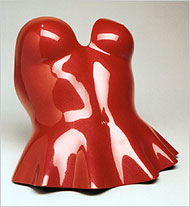Love and War
 Valerie Steele, director and chief curator of the Museum at FIT, has a knack for setting up polar opposites and then following them over the course of scores of carefully selected, beautifully displayed garments and accessories until they meet. “Love and War: The Weaponized Woman” is no exception.
Valerie Steele, director and chief curator of the Museum at FIT, has a knack for setting up polar opposites and then following them over the course of scores of carefully selected, beautifully displayed garments and accessories until they meet. “Love and War: The Weaponized Woman” is no exception. The show’s focus is the influence on contemporary and modern couture of garments of love and seduction (lingerie) and war (armor and military uniforms). These are not entirely new themes for this museum — both have been the subject of large exhibitions — but the specific examples are, as usual, fresh and in some cases hot off the runway, and their interaction is worth examining.
The show unfolds against a backdrop of Renaissance, Persian and Japanese armor from the Metropolitan Museum of Art and the Higgins Armory Museum in Worcester, Mass., that can cast even familiar objects in a new light. Martin Margiela’s split-toe Tabi boot is well known, for instance, but not often exhibited with an example of the Japanese foot armor that is one of its precedents. In addition a series of photographs by Tanya Marcuse emphasizes the sculptural kinship between these objects and 19th-century corsets and bustles.
In the main part of the exhibition, the twains of lingerie and armor, and seduction and aggression, converge and diverge in garments by some of the biggest names in fashion, past and present. One especially famous, and early, intersection is Issey Miyake’s 1983 red bustier, resin on molded plastic, which idealizes the female torso with considerable accuracy and also echoes a bronze cuirass from fourth-century B.C. Greece. Wearability is frequently disdained, most notably by a gilt metal robot bra and panties by Thierry Mugler, a silver coil corset by the jeweler Shaun Lee for Alexander McQueen and a fiberglass dress by Hussein Chalayan.
The considerably softer effect of slips and peignoirs on evening gown design is thoroughly considered. Two extraordinary, rather minimal dresses (one by Helmut Lang, the other by Yohji Yamamoto) find new uses for the narrow, pleated draping of Fortuny and Madame Grès. A black lace flapper-style dress by A. F. Vandevorst, while demure of line, openly reveals bra, panties and garter belt beneath. On the military front a Vandevorst jacket efficiently conjures up dress blues (both Navy and infantry) and a business suit.
There is a sizable contingent of black leather evening gowns, including an extraordinary embroidered one by John Galliano for Christian Dior that entails gleaming armor for one arm. But this is nothing. Mr. Galliano is also responsible for a black plastic and silk ensemble that looks ready for a Kurosawa movie set in medieval Japan. ROBERTA SMITH

0 Comments:
Post a Comment
<< Home